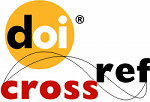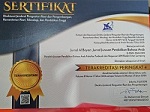The Contribution to Understanding the Study of Psycholinguistics in Facilitating Balaghah Learning
Abstract
Keywords
Full Text:
PDFReferences
Abdullah, Mohammed Harbi. “Arabic Diglossia and its Impact on the Social Communication and Learning Process of Non- Native Arabic Learners : Students’ Perspective.” Arab World English Journal. (King Khalid University, 2022).
Al-busaidi, Fatma, Abdullah Al Hashmi, Ali Al Musawi, and Ali Kazem. “Teachers’ Perceptions of the Effectiveness of Using Arabic Language Teaching Software in Omani Basic Education.” International Journal of Education and Development Using Information and Communication Technology 12, no. 2 (2016): 139-157.
Al-Hasyimy, Sayyid Ahmad. Jawahirul Balaghah. Beirut: al-Maktabat al-‘Ashriyyah, 1989.
Al-Omari, Fatmah. “Teaching Arabic Language for Non-Native Speakers in the Light of Modern Linguistics.” Dirasat: Human and Social Sciences 43, no. 3 (2016): 2529–2536. https://doi.org/10.35516/0103-043-003-018.
Albantani, Azkia Muharom, and Ahmad Madkur. “Musyahadat al Fidyu: Youtube-Based Teaching and Learning of Arabic as Foreign Language (AFL).” Dinamika Ilmu 17, no. 2 (2017): 291–308. https://doi.org/10.21093/di.v17i2.854.
Ani, Putri, and Septi Gumiandari. “Pembelajaran Bahasa Arab pada Anak Usia Dini Ditinjau dari Perspektif Psikolinguistik.” Jurnal Edukasi Nonformal 3, no. 2 (2022): 256-266.
Arifin, Zamri, Nur Khadijah Abu Bakar, Zaharom Ridzwan, and Ezad Azraai Jamsari. “Language Learning Strategies of Non-Muslim Students Applied to Arabic Language Course Inside and Outside the Classroom.” Ijaz Arabi Journal of Arabic Learning 4, no. 1 (2021): 1–11. https://doi.org/10.18860/ijazarabi.v4i1.9995.
Brosh, Hezi Y. “Arabic Language-Learning Strategy Preferences among Undergraduate Students.” Studies in Second Language Learning and Teaching 9, no. 2 (2019): 351–377. https://doi.org/10.14746/ssllt.2019.9.2.5.
Bahruddina, Uril, Muhammad Fadli Ramadhana, Halomoan Halomoan, Diaya Uddeen Deab Mahmoud Alzitawic, and M Abdul Hamid. “The Quality Improvement of the Interaction Indicators of the Arabic Language Learning in Higher Education.” Izdihar : Journal of Arabic Language Teaching, Linguistics, and Literature 4, no. 1 (2021): 59–70.
Dewey, Dan P., R. Kirk Belnap, and Rebecca Hillstrom. “Social Network Development, Language Use, and Language Acquisition during Study Abroad: Arabic Language Learners’ Perspectives.” Frontiers: The Interdisciplinary Journal of Study Abroad 22, no. 1 (2013): 84–110. https://doi.org/10.36366/frontiers.v22i1.320.
Ghani, Kamarulzaman Abdul, Mohammad Shiham Mahfuz, and Abdul Jamir Md Saad and Nik Mohd Rahimi Nik Yusofi. “Relationship between the Usage of Language Learning Strategies and the Level of Proficiency in Learning Arabic Ab Initio.” Asian Social Science 10, no. 9 (2014): 262–75. https://doi.org/10.5539/ass.v10n9p262.
Gobbetti, Marco, and Raffaella Di Cagno. The Language Scholar. UK: The University of Leeds, 2012. https://doi.org/10.1007/978-1-4614-5656-8_1.
Hilmi, Danial, and Nur Ila Ifawati. “Using the Blended Learning as an Alternative Model of Arabic Language Learning in the Pandemic Era.” Arabi : Journal of Arabic Studies 5, no. 2 (2020): 117-129. https://doi.org/10.24865/ajas.v5i2.294.
Itani, Talal. Qur’an English Translation: Clear, Pure, Easy to Read Modern English. Beirut: Clear Qur’an, 2012.
Kurniawan, Rio, Sugeng Sugiyono, and Tulus Musthofa. “Integrative Arabic Language Teaching of Integrated Islamic Elementary Schools in Solo Raya.” Arabiyat : Jurnal Pendidikan Bahasa Arab dan Kebahasaaraban 8, no. 1 (2021): 60–74. https://doi.org/10.15408/a.v8i1.20095.
Lian, Chaoqun. “Arabic Language Learning Anxiety in Chinese Social Media : A Study of Discursive Habitus and Language Symbolism.” Onomazein: Journal of Linguistics, Philology, and Translation 12, no. 9 (2021): 89–104. https://doi.org/10.7764/onomazein.ne9.06.
Lubis, Maimun Aqsha, Ismail Suardi Wekke, Melor Md Yunus, and Norazah Mohd Nordin. “Multicultural Approach and Information Communication Technology In Arabic Language Teaching: Research on Indonesian Pesantren.” Edute 2009: Proceedings of the 5Th Wseas/Iasme International Conference on Educational Technologies. (2009): 127–135.
Madzkur, Ali Ahmad. Tadrîs Funûn Al-Lughah Al-Arabiyyah. Kairo: Dar al Syawaf, 1991.
Mahdi, Rijal, and Ahmad Asri Lubis. “Perspectives on the Arabic Language from University Student: Between Reality and Hope.” Izdihar : Journal of Arabic Language Teaching, Linguistics, and Literature 3, no. 1 (2020): 45–58. https://doi.org/10.22219/jiz.v3i1.11757.
Marshall, Stephanie. Global Perspectives on Teaching and Learning in HE. A Handbook for Teaching and Learning in Higher Education. Vol. i, 2020. https://doi.org/10.4324/9780429259500-1.
Masrop, Noor Azli Mohamed, Hafawati Ishak, Ghazali Zainuddin, Siti Rosilawati Ramlan, Muhammad Sabri Sahir and Harwati Hashim. “Digital Games Based Language Learning for Arabic Literacy Remedial.” Creative Education 10, no. 2 (2019): 3213–3222. https://doi.org/10.4236/ce.2019.1012245.
Moh. Ulum, Siti Maisuroh, Rafika Milania, Moh. Taufiqur Rahman. “Realitas Pendidikan Bahasa Arab dan Faktor Pengaruh Pengembangan Kurikulum PBA di Sekolah.” Lisan An Nathiq: Jurnal Bahasa Dan Pendidikan Bahasa Arab 2, no. 2 (2021): 133–146.
Muhin, Rujiah, and Nik Mohd Rahimi Nik Yusoff. “Peranan Teori Psikolinguistik dalam Pendidikan Bahasa Arab.” International Journal of Advanced Research in Islamic Studies and Education Arise 1, no. 3 (2021): 107–116.
Munayf Hudhair al-Dhawiy. Al-Nadzhoriyah al-Binaiyyah wa Tathbiyquha fi Tadris al- Lughah al-’Arabiyah. Rafhaa: Maktabah al-Malik Fahdh al-Wathaniyah, 2013.
Padil, Hazlina Mohd, Anie Farahida Omar, Mohd Syahril Ibrahim, Amylia Fuziana Azmi, and Nor Laila Ahmad. “Online Shopping: Analysis of Students’ Experience.” In Proceedings: International Invention, Innovative & Creative (InIIC) Conference, 61–66. Malaysia: MNNF Publisher, 2019.
Prihartini, Yogia, and Wahyudi Buska. “Lecturers’ Speech Acts in Arabic Language Learning Interactions at UIN Sulthan Thaha Saifuddin Jambi.” Al-Ta Lim Journal 27, no. 1 (2020): 41–57. https://doi.org/10.15548/jt.v27i1.597.
Ritonga, Mahyudin, Asrina, Rizka Widayanti, Fitri Alrasi, Julhadi, and Syaflin Halim. “Analysis of Arabic Language Learning at Higher Education Institutions with Multi-Religion Students.” Universal Journal of Educational Research 8, no. 9 (2020): 4333–4339. https://doi.org/10.13189/ujer.2020.080960.
Ritonga, Mahyudin, Martin Kustati, Meliza Budiarti, Ahmad Lahmi, Musda Asmara, Rahadian Kurniawan, Neli Putri, and Endri Yenti. “Arabic as Foreign Language Learning in Pandemic COVID-19 as Perceived by Students and Teachers.” Linguistics and Culture Review 5, no. 1 (2021): 75–92. https://doi.org/10.21744/lingcure.v5n1.726.
Ritonga, Mahyudin, Hendro Widodo, Munirah, and Talqis Nurdianto. “Arabic Language Learning Reconstruction as a Response to Strengthen al-Islam Studies at Higher Education.” International Journal of Evaluation and Research in Education 10, no. 1 (2021): 355–363. https://doi.org/10.11591/ijere.v10i1.20747.
Schunk, Dale H. Learning Theories an Educational Perspective. VI. (Yogyakarta: Pustaka Pelajar, 2018).
Setiadi, Fadlan Masykura. “Pendekatan Psikolinguistik Bahasa Arab di Indonesia.” Ihya al-Arabiyah: Jurnal Pendidikan Bahasa dan Sastra Arab 6, no. 1 (2020): 57-68.
Suryani, Khotimah. “Hubungan Ilmu Psikolinguistik dengan Pendekatan Komunikatif alam Pembelajaran Bahasa Arab.” Dar el-Ilmi : Jurnal Studi Keagamaan, Pendidikan dan Humaniora 9, no. 2 (2022): 133–152. https://doi.org/10.52166/darelilmi.v9i2.3514.
Syuhadak, Syuhadak, Danial Hilmi, and Inayatur Rosyidah. “Arabic Language Learning with Multicultural Perspective at State Islamic Universities in East Java.” Lisania: Journal of Arabic Education and Literature 5, no. 2 (2021): 129–143. https://doi.org/10.18326/lisania.v5i2.129-143.
Tamaji, Sampiril Taurus. “Analisis Teori Psikolinguistik dalam Perkembangan Pembelajaran Bahasa Arab.” al-Fakkaar: Jurnal Ilmiah Pendidikan Bahasa Arab 1, no. 1 (2020): 57–77.
Teh, Kamarul Shukri Mat, Mohamed Aminm Embi, Nik Mohd Rahimi Nik Yusoff, and Zamri Mahamod. “A Closer Look at Gender and Arabic Language Learning Strategies Use.” European Journal of Social Sciences 9, no. 3 (2009): 399–407.
Tjalau, Cutri A, and Saida Gani. “Physiological Aspects dalam Bahasa Arab ; Kajian Psikolinguistik.” ‘A Jamiy: Jurnal Bahasa dan Sastra Arab 11, no. 2 (2022): 504–515. https://doi.org/10.31314/ajamiy.11.2.504-515.2022.
Trentman, Emma. “Imagined Communities and Language Learning during Study Abroad: Arabic Learners in Egypt.” Foreign Language Annals 46, no. 4 (2013): 545–564. https://doi.org/10.1111/flan.12054.
Wargadinata, Wildana, Iffat Maimunah, Saidna Zulfiqar Bin Tahir, Umanailo and M Chairul Basrun. “Arabic Creative and Participative Learning : In Search of a New Way of Language Learning by ‘ El Jidal Reborn ’ Youth Community in Malang Universitas Islam Negeri Maulana Malik Ibrahim Malang , Indonesia.” International Journal of Advanced Science and Technology 2, no. 8 (2020): 4319–4332.
Wekke, Ismail Suardi, and Maimun Aqsha Lubis. “A Multicultural Approach in Arabic Language Teaching: Creating Equality at Indonesian Pesantren Classroom Life.” Sosiohumanika 1, no. 2 (2016): 295–310.
Yusuf, Muhammad. “Psikolinguistik dalam Metodologi Pembelajaran Bahasa Arab di Era Postmetode.” al Mi’yar: Jurnal Ilmiah Pembelajaran Bahasa Arab dan Kebahasaaraban 2, no. 2 (2019): 183-202. https://doi.org/10.35931/am.v2i2.123.
Zurqoni, Heri Retnawati, Syarifatur Rahmatullah, Hasan Djidu, and Ezi Apino. “Has Arabic Language Learning Been Successfully Implemented?” International Journal of Instruction 13, no. 4 (2020): 715–730. https://doi.org/10.29333/iji.2020.13444a.
DOI: http://dx.doi.org/10.24042/albayan.v15i1.14462
Refbacks
- There are currently no refbacks.
Copyright (c) 2023 Jurnal Al Bayan: Jurnal Jurusan Pendidikan Bahasa Arab
License URL: https://creativecommons.org/licenses/by-nc-sa/4.0
Editorial Office:
Jurnal Al Bayan: Jurnal Jurusan Pendidikan Bahasa Arab, Arabic Education Study Program, Faculty of Education and Teachers Training, Unversitas Islam Negeri Raden Intan Lampung
Jl. Endro Suratmin 1 Sukarame, Bandar Lampung 35131-Indonesia
e-mail: jurnalalbayan@radenintan.ac.id
http://ejournal.radenintan.ac.id/index.php/albayan/index
Jurnal Al Bayan: Jurnal Jurusan Pendidikan Bahasa Arab is licensed under a Creative Commons Attribution-ShareAlike 4.0 International License. p-ISSN 2086-9282 | e-ISSN 2549-1229









